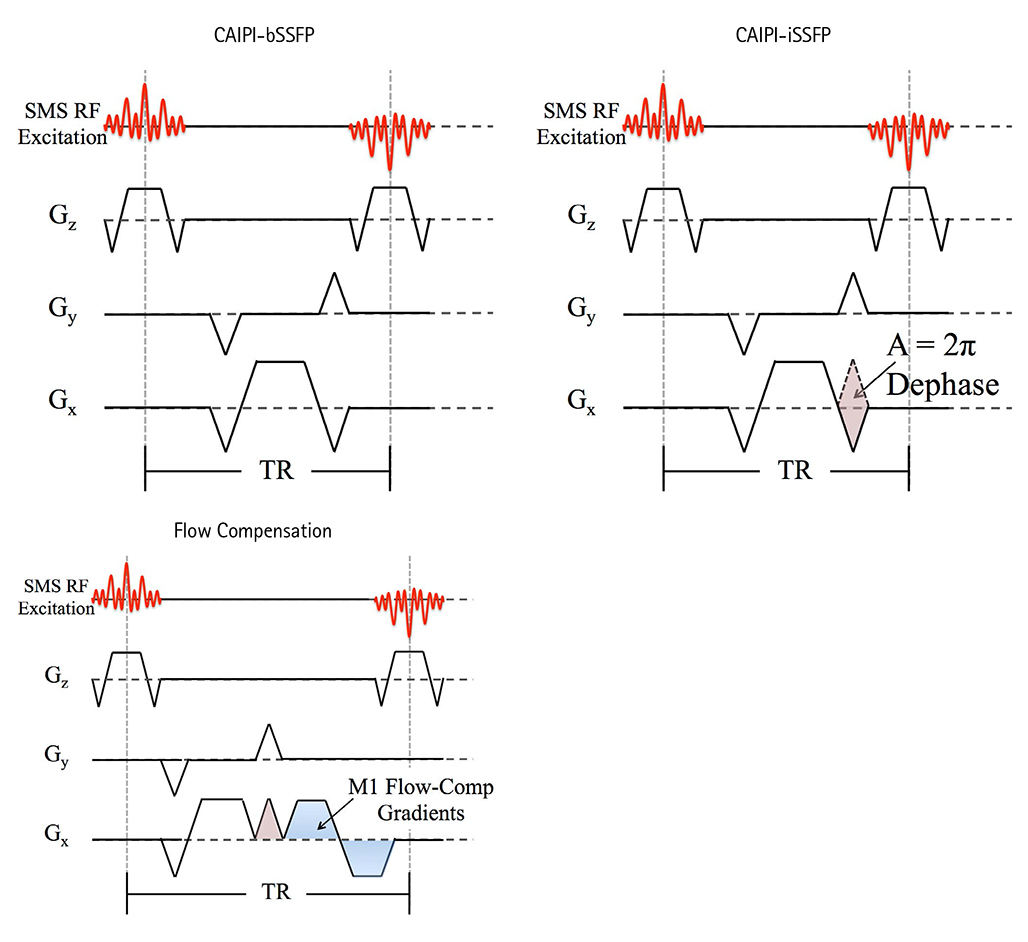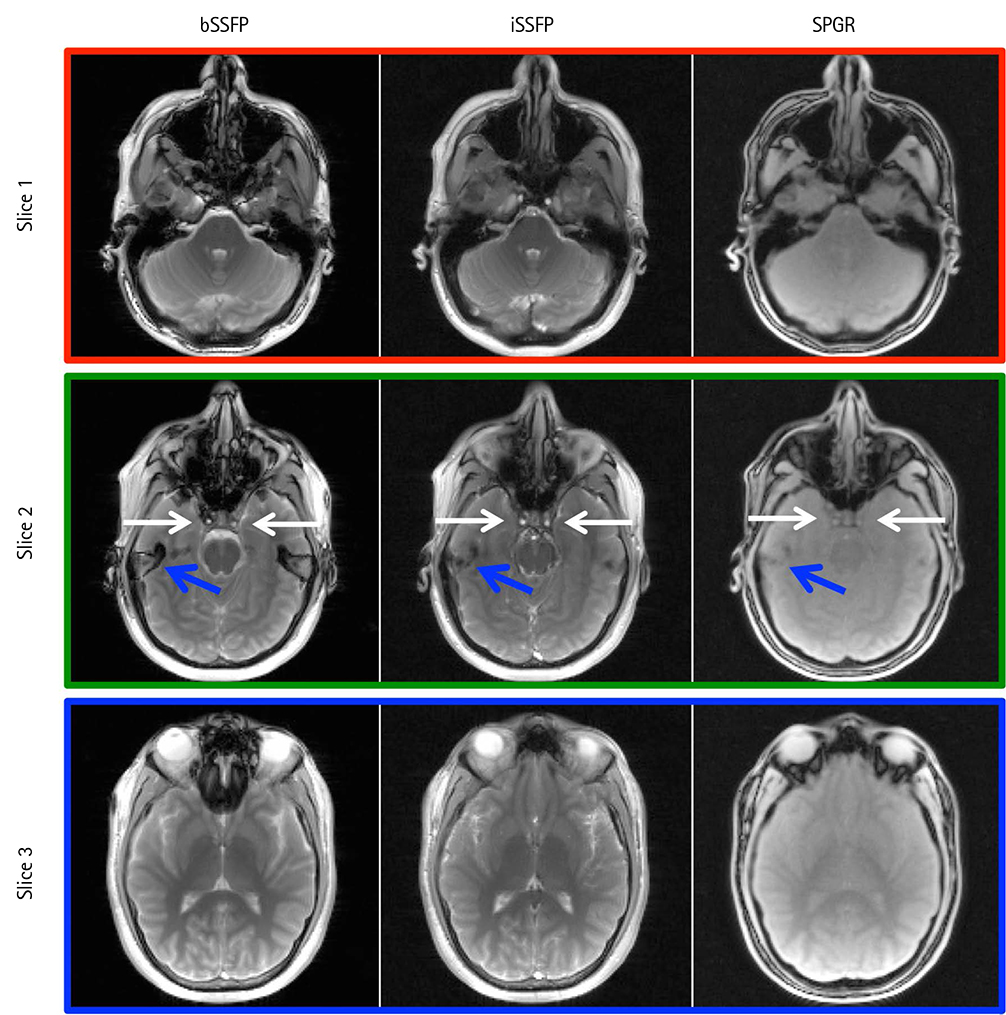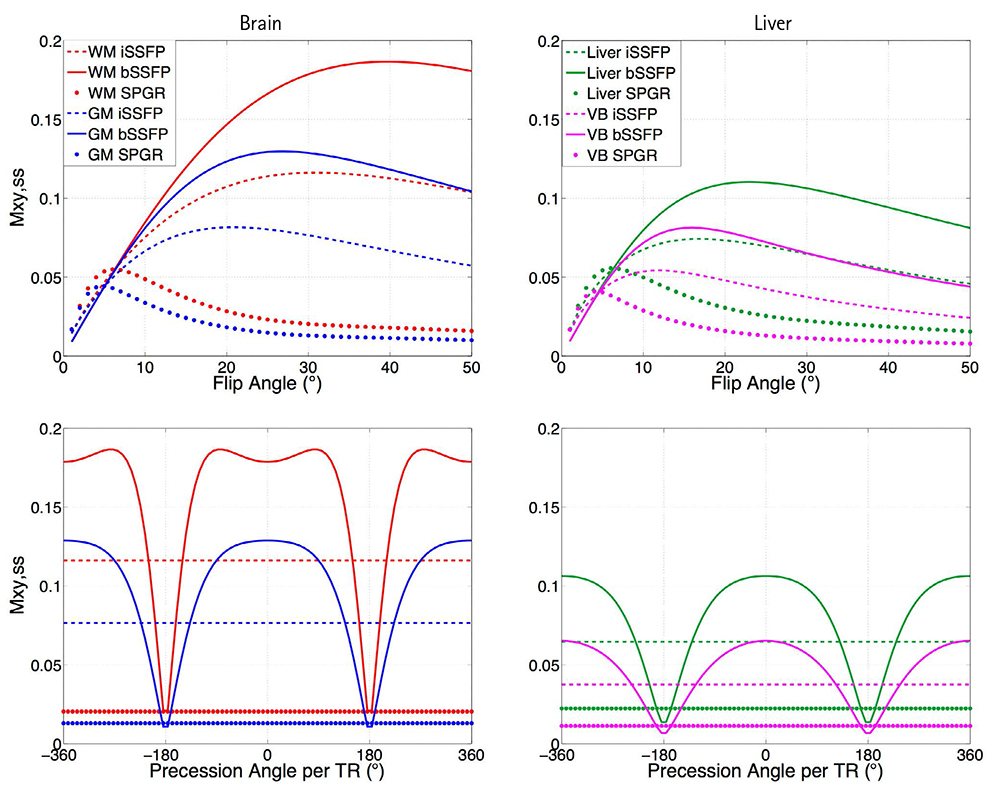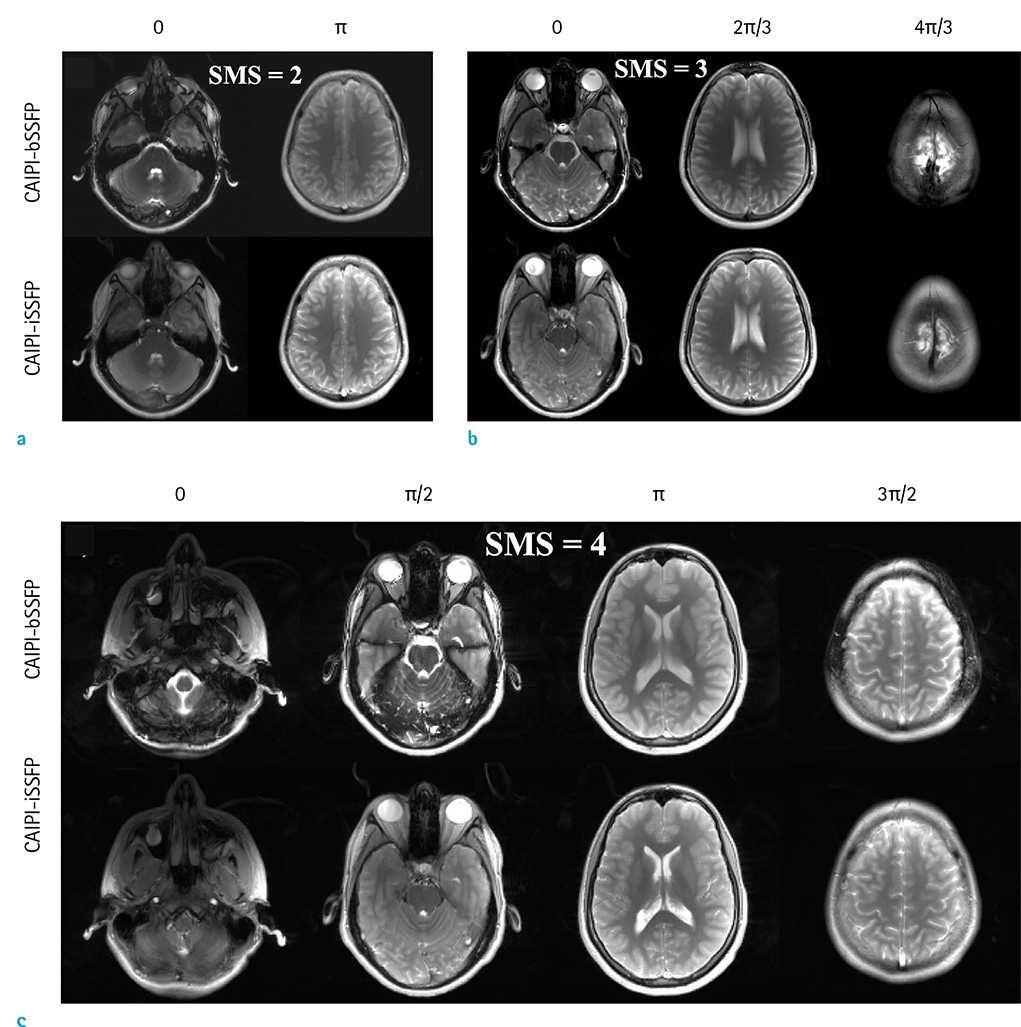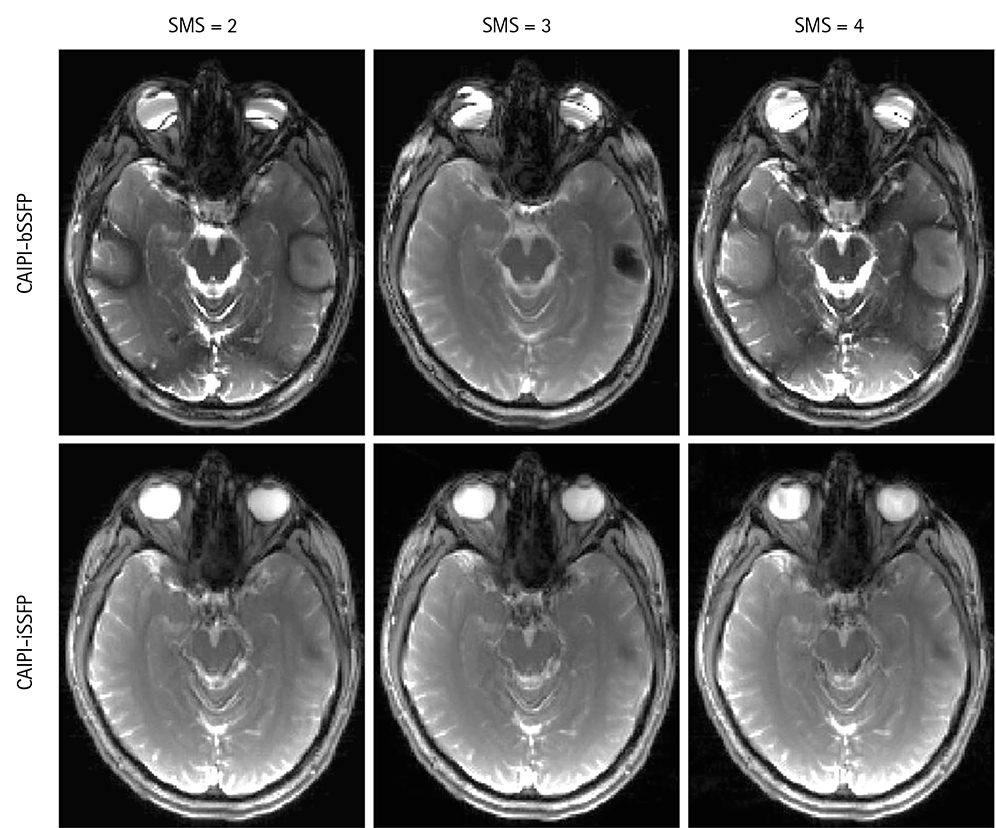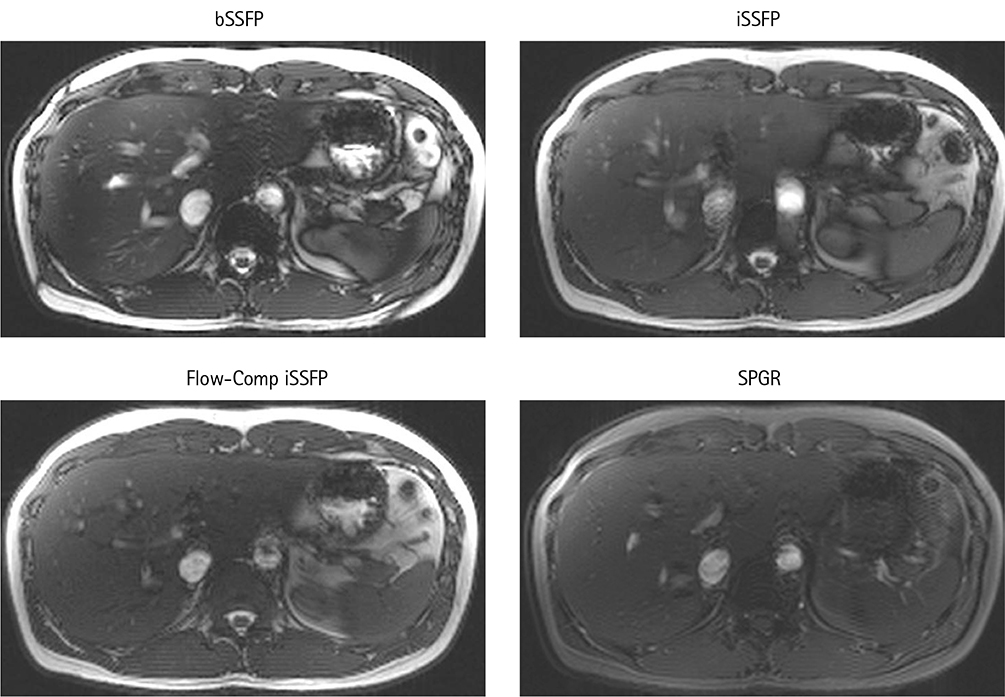Investig Magn Reson Imaging.
2017 Dec;21(4):210-222. 10.13104/imri.2017.21.4.210.
Highly Accelerated SSFP Imaging with Controlled Aliasing in Parallel Imaging and integrated-SSFP (CAIPI-iSSFP)
- Affiliations
-
- 1Department of Radiological Sciences, University of California Los Angeles, California, USA.
- 2Philips, MR Clinical Science NA, Florida, USA.
- 3Laboratory of FMRI Technology (LOFT), Stevens Neuroimaging and Informatics Institute, University of Southern California, California, USA. jwang71@gmail.com
- 4Center of Magnetic Resonance Research, University of Minnesota, Minnesota, USA.
- KMID: 2400375
- DOI: http://doi.org/10.13104/imri.2017.21.4.210
Abstract
- PURPOSE
To develop a novel combination of controlled aliasing in parallel imaging results in higher acceleration (CAIPIRINHA) with integrated SSFP (CAIPI-iSSFP) for accelerated SSFP imaging without banding artifacts at 3T.
MATERIALS AND METHODS
CAIPI-iSSFP was developed by adding a dephasing gradient to the balanced SSFP (bSSFP) pulse sequence with a gradient area that results in 2Ï€ dephasing across a single pixel. Extended phase graph (EPG) simulations were performed to show the signal behaviors of iSSFP, bSSFP, and RF-spoiled gradient echo (SPGR) sequences. In vivo experiments were performed for brain and abdominal imaging at 3T with simultaneous multi-slice (SMS) acceleration factors of 2, 3 and 4 with CAIPI-iSSFP and CAIPI-bSSFP. The image quality was evaluated by measuring the relative contrast-to-noise ratio (CNR) and by qualitatively assessing banding artifact removal in the brain.
RESULTS
Banding artifacts were removed using CAIPI-iSSFP compared to CAIPI-bSSFP up to an SMS factor of 4 and 3 on brain and liver imaging, respectively. The relative CNRs between gray and white matter were on average 18% lower in CAIPI-iSSFP compared to that of CAIPI-bSSFP.
CONCLUSION
This study demonstrated that CAIPI-iSSFP provides up to a factor of four acceleration, while minimizing the banding artifacts with up to a 20% decrease in the relative CNR.
Keyword
MeSH Terms
Figure
Reference
-
1. Miller KL, Tijssen RH, Stikov N, Okell TW. Steady-state MRI: methods for neuroimaging. Imaging Med. 2011; 3:93–105.
Article2. Carr H. Steady-state free precession in nuclear magnetic resonance. Phys Rev. 1958; 112:1693–1701.
Article3. Bieri O, Scheffler K. Fundamentals of balanced steady state free precession MRI. J Magn Reson Imaging. 2013; 38:2–11.
Article4. Scheffler K, Lehnhardt S. Principles and applications of balanced SSFP techniques. Eur Radiol. 2003; 13:2409–2418.
Article5. Oppelt A, Graumann R, Barfuß H, Fischer H, Hartl W, Schajor W. FISP: a new fast MRI sequence. Electromedica. 1986; 54:15–18.6. Duerk JL, Lewin JS, Wendt M, Petersilge C. Remember true FISP? A high SNR, near 1-second imaging method for T2-like contrast in interventional MRI at .2 T. J Magn Reson Imaging. 1998; 8:203–220.7. Pruessmann KP, Weiger M, Scheidegger MB, Boesiger P. SENSE: sensitivity encoding for fast MRI. Magn Reson Med. 1999; 42:952–962.
Article8. Robson PM, Grant AK, Madhuranthakam AJ, Lattanzi R, Sodickson DK, McKenzie CA. Comprehensive quantification of signal-to-noise ratio and g-factor for image-based and k-space-based parallel imaging reconstructions. Magn Reson Med. 2008; 60:895–907.9. Larkman DJ, Hajnal JV, Herlihy AH, Coutts GA, Young IR, Ehnholm G. Use of multicoil arrays for separation of signal from multiple slices simultaneously excited. J Magn Reson Imaging. 2001; 13:313–317.
Article10. Setsompop K, Cohen-Adad J, Gagoski BA, et al. Improving diffusion MRI using simultaneous multi-slice echo planar imaging. Neuroimage. 2012; 63:569–580.
Article11. Breuer FA, Blaimer M, Heidemann RM, Mueller MF, Griswold MA, Jakob PM. Controlled aliasing in parallel imaging results in higher acceleration (CAIPIRINHA) for multi-slice imaging. Magn Reson Med. 2005; 53:684–691.
Article12. Stäb D, Ritter CO, Breuer FA, Weng AM, Hahn D, Köstler H. CAIPIRINHA accelerated SSFP imaging. Magn Reson Med. 2011; 65:157–164.
Article13. Haacke EM, Wielopolski PA, Tkach JA, Modic MT. Steady-state free precession imaging in the presence of motion: application for improved visualization of the cerebrospinal fluid. Radiology. 1990; 175:545–552.
Article14. Hargreaves BA. Rapid gradient-echo imaging. J Magn Reson Imaging. 2012; 36:1300–1313.
Article15. Khajehim M, Nasiraei-Moghaddam A, Hossein-Zadeh GA, Martin T, Wang D. A quantitative analysis of fMRI induced phase changes using averaged-BOSS (A-BOSS). In : In Proceedings of the 23rd Scientific Meeting of International Society for Magnetic Resonance in Medicine; Toronto. 2015. p. 3921.16. Shams Z, Moghaddam AN. Averaged-BOSS: feasibility study and preliminary results. In : In Proceedings of the 22nd Scientific Meeting of International Society for Magnetic Resonance in Medicine; Milan. 2014. p. 4216.17. Zur Y, Wood ML, Neuringer LJ. Spoiling of transverse magnetization in steady-state sequences. Magn Reson Med. 1991; 21:251–263.
Article18. Crawley AP, Wood ML, Henkelman RM. Elimination of transverse coherences in FLASH MRI. Magn Reson Med. 1988; 8:248–260.
Article19. Sekihara K. Steady-state magnetizations in rapid NMR imaging using small flip angles and short repetition intervals. IEEE Trans Med Imaging. 1987; 6:157–164.
Article20. Scheffler IE, Elson EL, Baldwin RL. Helix formation by dAT oligomers. I. Hairpin and straight-chain helices. J Mol Biol. 1968; 36:291–304.21. Breuer FA, Blaimer M, Mueller MF, et al. Controlled aliasing in volumetric parallel imaging (2D CAIPIRINHA). Magn Reson Med. 2006; 55:549–556.
Article22. Haacke EM, Lenz GW. Improving MR image quality in the presence of motion by using rephasing gradients. AJR Am J Roentgenol. 1987; 148:1251–1258.
Article23. Axel L, Morton D. MR flow imaging by velocity-compensated/uncompensated difference images. J Comput Assist Tomogr. 1987; 11:31–34.
Article24. Simonetti OP, Wendt RE 3rd, Duerk JL. Significance of the point of expansion in interpretation of gradient moments and motion sensitivity. J Magn Reson Imaging. 1991; 1:569–577.
Article25. Weigel M. Extended phase graphs: dephasing, RF pulses, and echoes - pure and simple. J Magn Reson Imaging. 2015; 41:266–295.
Article26. Wansapura JP, Holland SK, Dunn RS, Ball WS Jr. NMR relaxation times in the human brain at 3.0 tesla. J Magn Reson Imaging. 1999; 9:531–553.
Article27. Wang Y, Moeller S, Li X, et al. Simultaneous multi-slice Turbo-FLASH imaging with CAIPIRINHA for whole brain distortion-free pseudo-continuous arterial spin labeling at 3 and 7 T. Neuroimage. 2015; 113:279–288.28. Xiang QS, Hoff MN. Banding artifact removal for bSSFP imaging with an elliptical signal model. Magn Reson Med. 2014; 71:927–933.
Article29. Mikaiel S, Martin T, Sung K, Wu H. Real-time golden angle radial iSSFP for interventional MRI. In : In Proceedings of the 24th Scientific Meeting of International Society for Magnetic Resonance in Medicine; Singapore. 2016. p. 3579.30. Sun K, Xue R, Zhang P, et al. Integrated SSFP for functional brain mapping at 7T with reduced susceptibility artifact. J Magn Reson. 2017; 276:22–30.31. Kim MO, Hong T, Kim DH. Multislice CAIPIRINHA using view angle tilting technique (CAIPIVAT). Tomography. 2016; 2:43–48.
Article32. Kim D, Seo H, Oh C, Han Y, Park H. Multi-slice imAGe generation using intra-slice paraLLel imaging and Inter-slice shifting (MAGGULLI). Phys Med Biol. 2016; 61:1692–1704.
Article33. Bilgic B, Gagoski BA, Cauley SF, et al. Wave-CAIPI for highly accelerated 3D imaging. Magn Reson Med. 2015; 73:2152–2162.
Article34. Setsompop K, Gagoski BA, Polimeni JR, Witzel T, Wedeen VJ, Wald LL. Blipped-controlled aliasing in parallel imaging for simultaneous multislice echo planar imaging with reduced g-factor penalty. Magn Reson Med. 2012; 67:1210–1224.
Article35. Bieri O, Scheffler K. Flow compensation in balanced SSFP sequences. Magn Reson Med. 2005; 54:901–907.
Article36. Wang Y, Shao X, Martin T, Moeller S, Yacoub E, Wang DJ. Phase-cycled simultaneous multislice balanced SSFP imaging with CAIPIRINHA for efficient banding reduction. Magn Reson Med. 2016; 76:1764–1774.
Article37. Gagoski BA, Bilgic B, Eichner C, et al. RARE/turbo spin echo imaging with simultaneous multislice wave-CAIPI. Magn Reson Med. 2015; 73:929–938.
Article
- Full Text Links
- Actions
-
Cited
- CITED
-
- Close
- Share
- Similar articles
-
- Feasibility of Three-Dimensional Balanced Steady-State Free Precession Cine Magnetic Resonance Imaging Combined with an Image Denoising Technique to Evaluate Cardiac Function in Children with Repaired Tetralogy of Fallot
- In Vivo and In Vitro Studies of the Steady State Free Precession-Diffusion-Weighted MR Imagings on Low b-value: Validation and Application to Bone Marrow Pathology
- Diagnostic Performance of Diffusion-Weighted Steady-State Free Precession in Differential Diagnosis of Neoplastic and Benign Osteoporotic Vertebral Compression Fractures: Comparison to Diffusion-Weighted Echo-Planar Imaging
- 3D Whole-Heart Coronary MR Angiography at 1.5T in Healthy Volunteers: Comparison between Unenhanced SSFP and Gd-Enhanced FLASH Sequences
- The Usefulness of Stress Perfusion MR using Steady State Free Precession Sequence for Depiction of Significant Coronary Artery Stenosis

